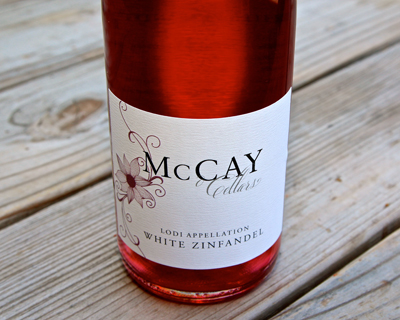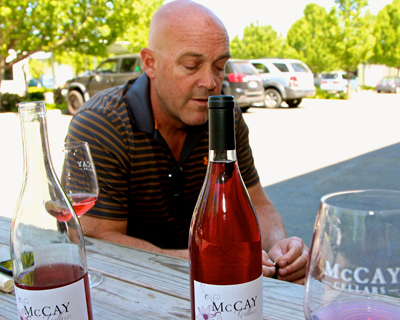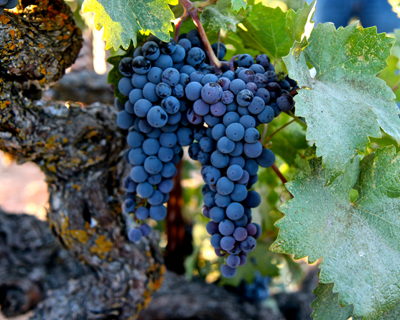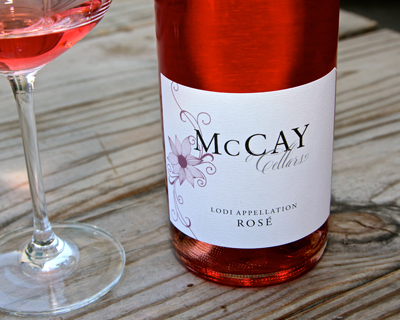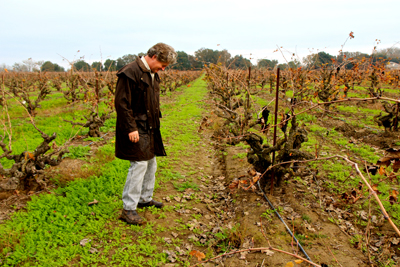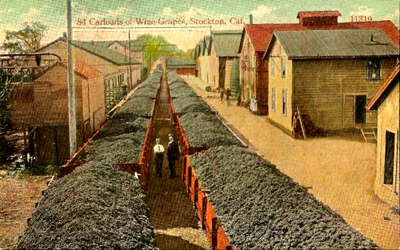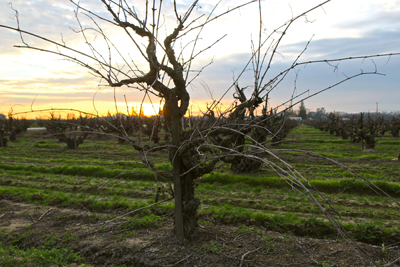Letters from Lodi
An insightful and objective look at viticulture and winemaking from the Lodi
Appellation and the growers and vintners behind these crafts. Told from the
perspective of multi-award winning wine journalist, Randy Caparoso.
White Zinfandel is back, and better (when seriously dry) than ever!
McCay Cellar Lodi Appellation White Zinfandel
The crying of Lot 13
Don't look now, but White Zinfandel may be back, and better than ever!
That is to say, White Zinfandel vinified more like a connoisseur’s wine: bone-dry – not a hint of residual sugar in the taste – and from intensely flavorful, ancient vine fruit.
McCay Cellars winemaker/owner Michael McCay
The 2014 McCay Cellars Lodi White Zinfandel ($18) may very well be the bottling that revives the category in the Lodi winegrowing region. Bottled just this past mid-March, McCay Cellars owner/winemaker Michael McCay tells us, "Right now the wine is screaming 'pomegranate'" – in reference to the wine's brilliant, penetrating red fruit inflected perfume, and fresh, lively, tart (but not sharp), zingy taste.
This is Mr. McCay's first-ever White Zinfandel – earning him kudos, since none of Lodi's other small, artisanal wineries specializing in Zinfandel have ventured into this popular but pooh-poohed category, generally considered the "fruit punch" of varietal wines.
Like any proper "White Zinfandel" – one of the wine world's strangest, yet commonly accepted, misnomers, since White Zinfandel never looks like a "white" wine – the 2014 McCay is a vivid, transparent, flamingo-pink color; part of this cast coming from pigments from the Zinfandel fruit when juice was pressed off the its black colored skins (like almost all of the world's red wine grapes, the pulp of the Zinfandel fruit is clear white – color is derived from the skins), and part of this color also coming from an artful blending of 2014 red wine made from Carignan (about 3%) from a neighboring planting (the Rauser Vineyard, with vines dating back to 1906).
McCay picked his "White" Zinfandel from his Lot 13 Vineyard (own-rooted vines originally planted in 1915) on Mokelumne River-Lodi's east side, which is known to make an incredibly intense yet naturally delicate, almost Pinot Noir-like red wine. The grapes were picked earlier than McCay's normal red wine harvest at lower sugar levels (average 22° Brix, which converted to 13% alcohol in the finished wine) and higher natural acidity, which are more optimal for pale pink style of winemaking.
McCay Cellars’ Lot 13 Vineyard Zinfandel
The quality of the ancient vines pushes through, despite the wine's outwardly fresh, ebullient character: the pomegranate/pear juice-like sensations in the nose are tucked into zippy yet meaty, viscous sensations on the palate that come across as both fruity and earthy, almost Provençal-like.
Mr. McCay lets the wine take its time to achieve these subtleties: after pressing, he lets the juice sit quietly in small stainless steel drume in a cold room (kept at 40° F.) for over 30 days, before being brought out to warm up and begin a slow fermentation on its own native yeast, which enhances the earthy, organic quality of the wine.
Says McCay, "When the wine sits in the cold room it remains in contact with some of the skins and seeds – the meaty parts of the grape that give the bright, natural flavor. Nothing is added during fermentation – no water to lower alcohol, no acid adjustment or cultured yeasts. The goal is not to try to make 'something,' but to let the wine be what it wants to be."
The result is a flamingo-pink wine that is as light, skipping and picnic-perfect as any dry rosé, but with a textural "oomph" and depth of flavor similar to a red wine. To demonstrate the subtle difference, Mr. McCay also poured us a taste of his 2014 McCay Cellars Lodi Rosé ($18), made in pretty much the same way as the White Zinfandel.
McCay’s rosé is fashioned from Grenache (60%) from the trellised, but impeccably farmed, Abba Vineyard, plus Carignan (40%) from the 109-year-old Rauser Vineyard. This is more of a classic, Southern French style, dry pink wine, with its salmon/orange pink toned color, fragrant strawberry perfume with earthy/scrubby tones, and light (12.5%), crisp, feathery, almost balletic feel and brightness – in contrast to the White Zinfandel's firmer, gripping feel, wonderful in its own, breezy way.
No doubt about it, Zinfandel makes a fantastic, deep, sophisticated dry pink wine. Too bad there isn’t more of it!
McCay Cellars Lodi Appellation Rosé
A little bit of baggariddim on White Zinfandel
While we're on the subject, let's geek out a little bit on the history of White Zinfandel in California.
In the late 1960s and early 1970s White Zinfandel was, as a matter of fact, considered one of California's most innovative, sophisticated wines – the opposite of the ubiquitous, tutti-fruity grocery-shelf image it would have by the late '70s and 1980s. Early on, the only wineries that made White Zinfandel were cutting-edge, boutique sized producers; such as, at first, David Bruce Winery and Ridge Vineyards in Santa Cruz Mountains, and then a couple of wineries sourcing Zinfandel from Amador County, Montevina Winery and Sutter Home Wines (despite the fact that the latter was always based in Napa Valley).
Like David Bruce, Ridge and Montevina, in the beginning Sutter Home made a series of bone-dry style White Zinfandels in the early '70s, calling it Oeil de Perdrix – a moniker borrowed from older French and Swiss names for pale, almost grayish-pink rosé wines (similar to vin gris) suggesting the pale pink color in the eyes of a partridge, presumably during death throes.
Unlike the viscous yet sleek, supple styles of contemporary producers like McCay Cellars, these earlier styles of White Zinfandel were also curiosities because they retained a tinge of red wine-like tannin bitterness, coming across like Italian amaro ("bitter") cocktails. The tannin dryness – primarily extracted from the use of the harsher crusher-destemmers of those days – lent a mild but pleasant, palate cleansing effect. In his ground-breaking book, Gorman on California Premium Wines (1976), Robert Gorman talked about the "bitter edge" of Sutter Home's 1972 White Zinfandel, likening it to the "refreshing aperitif of Burgundy known as 'Kir'."
Well known visiting Sonoma winemaker Greg La Follette bows before a 100-year old Zinfandel vine in McCay’s Lot 13 Vineyard (December 2014)
In The University of California/Sotheby Book of California Wine (1984), Ridge Vineyards' longtime chief winemaker (now CEO) Paul Draper prescribed the method used to give these early White Zinfandels their unique, hybrid-ish qualities:
If a good deal of fruit is retained, it can be more elegant when fairly dry. For the whitest wine with the least tint of red color, the juice is best drawn off at the crusher or crushing hopper. If drawn off at the press, there seems to be more color. It is then cooled and usually either centrifuged or fined to reduce solids. A yeast culture is added, often the Montrachet strain to accentuate fruitiness.
Once fermentation is begun, the juice is typically held at 50° to 55° F., which lengthens fermentation time to approximately three or four weeks. It is racked off or centrifuged off the lees, and sulfur is added. Malolactic fermentation is not considered desirable. Aging is often in large tanks, either stainless steel or, if possible, oak, to aid clarification and add complexity. After three or four months in the tank, it is fined, chilled to eliminate the possibility of later precipitation of tartrate crystals, then filtered and bottled. It is best served cold.
19th century postcard of El Pinal Winery
Reportedly, early Sutter Home Oeil de Perdrix wines were primarily saignées – or "bleeds" of pale colored juice drawn off of tanks of Zinfandel that went through the crusher, then were fermented skins-seeds-and-all into normal red wine. The story goes that in 1975 Sutter Home had one large tank of White Zinfandel that experienced a stuck fermentation (i.e. when the yeasts are not able to convert all the sugars into alcohol), leaving the wine with a perceptible amount of residual sugar.
At first this stuck tank was considered a "problem," and the wine was set aside. But when Sutter Home’s winemaker tasted the light, sweet White Zinfandel and found it to be attractive, a decision was made to go ahead and bottle the wine "as is" – which proved to be far, far more popular than the dry, mildly bitter Oeil de Perdrix bottlings of previous vintages.
Sutter Home's medium-sweet style of White Zinfandel, in fact, would completely transform the genre, with widespread ramifications in the grape growing industry. The 1980s, remember, was a period of time when many of Lodi's vineyards were transitioning from the table grape Flame Tokay, and when "jug wine" grapes such as Carignan and Colombard were being pulled out and replanted with premium "varietals" (Cabernet Sauvignon, Chardonnay, Merlot, etc.) that were suddenly the rage.
If not for the explosive market for fruity White Zinfandel, most of the ancient vine Zinfandel plantings in Lodi and elsewhere in the state would have been ripped out as well. Luckily – for today's red Zinfandel lovers – those vines would still be there when Zinfandel began to make its comeback, during the mid-to-late '90s.
That was how the popular style of White Zinfandel got started in the late 1970s – as an accident – but did you know that the first winery to actually produce a rosé or pinkish "White Zinfandel" was El Pinal Winery, way back in 1869? El Pinal was founded in the Stockton area by George West, whose family-run production facilities sourced almost all of their fruit from vineyards in the Lodi area right up until Prohibition.
According to Charles Lewis Sullivan in his book, Zinfandel: A History of a Grape and Its Wines, El Pinal's technique of turning free-run Zinfandel juice into a pinkish wine was so highly thought of that California viticultural commissioner Charles Wetmore – a pioneer of California white wines, and also the founder of Livermore Valley's Cresta Blanca Winery (est. 1882) – openly advocated the use of Zinfandel to produce a "white" wine.
We have no idea, of course, whether or not the El Pinal bottlings were finished dry or sweet, bright pink or barely pink at all – only that the idea of utilizing the black skinned Zinfandel grape to make "white" wine goes back a long ways, starting in the Lodi area.
Maybe it's time for Lodi to become a leader in the reframing of this once-innovative, historic style of winemaking!
109-year-old, own-rooted Rauser Vineyard Carigan (next door to McCay’s Lot 13 and Kirschenmann Vineyard): a survivor from recent uprootings, and now a major component in McCay pink and red wines
